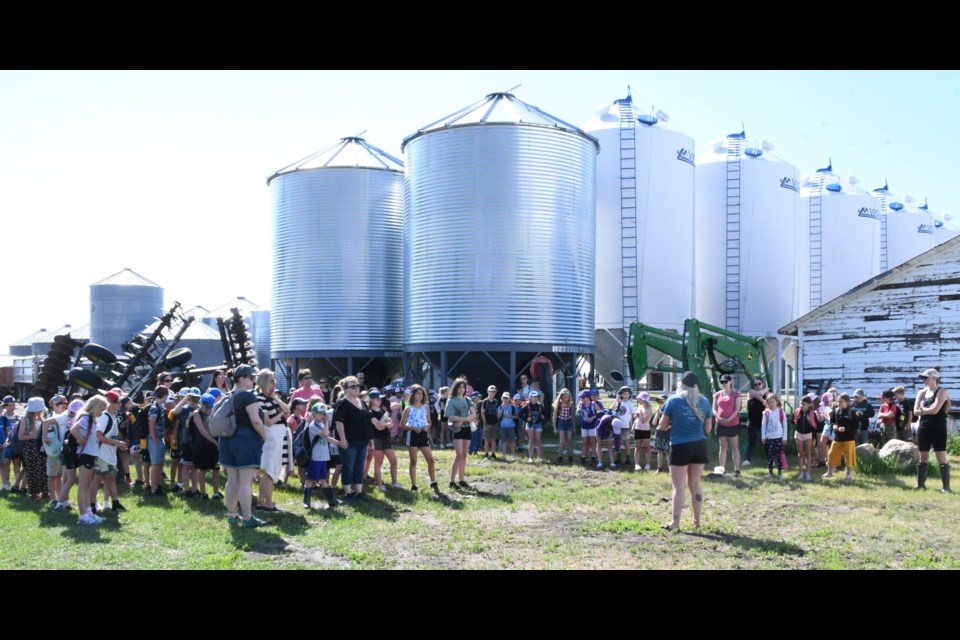MOOSE JAW — A little mud couldn’t stop hundreds of young students from immersing themselves in the sights, sounds and smells of the agriculture industry during a visit to an area farm recently.
Students in grades 2 to 4 from Sunningdale and Lindale schools visited Gordon Knox’s farm east of Moose Jaw on June 8 to participate in Agriculture in the Classroom — Saskatchewan’s (AITC-SK) Food Farm Program. The initiative teaches children from where their food comes and has them participate in ag-related stations.
At the Knox farm, students answered questions about agriculture, learned about farm safety, explored a combine, identified crops and seeds, learned about soil levels and root systems, discovered how watersheds work, planted seeds and turned cream into butter.
Sunningdale teacher Alicia Huschi brought her Grade 3 students because they have been learning about plants, while she thought the Farm Food Program meshed well with the curriculum. She appreciated the station-based activities and thought attending would be a nice field trip.
“What’s interesting is to know what the kids have retained. I think that’s my favourite part … and also how engaged they are at learning the different things,” she said, “because all my students aren’t from farms, so a lot of it is new to them.”
Student Carter Peterson thought it was “pretty cool” to spend time on a farm — he’s a city kid — while his favourite part was sitting inside a combine because it had many buttons and was tall.
“I (also) learned there are other foods (and liquids) that can look like chemicals, so you have to be careful about what you eat,” the Grade 3 Sunningdale School student added.
Student Ruby Campbell thought the trip was fun, especially making butter — which saw her and other students furiously shaking a small tube to turn milk into a solid.
Another activity the Grade 4 Lindale School girl enjoyed was learning about farm safety using a toy-sized hopper — a trailer —filled with canola seeds and a Lego person the students named “Karen.” The activity leader showed the students that people could sustain injuries — or death — if they played in the machine.
“She (Karen) died because she went through the middle of the hopper (out the bottom) and she didn’t make it out alive,” Campbell exclaimed, adding while she lived on a farm, she still learned new things.
The Knox family has hosted the Food Farm Program since it started 10 years ago because they think it’s important to remind students that their food doesn’t originate in a grocery store, explained Gordon Knox, a third-generation Saskatchewan producer who works with his dad and sister.
“They’re (students) pretty detached from the farm and how our food is grown nowadays … ,” he said.
Knox likes working in agriculture — he has been a producer since 1996 — because it’s challenging, rewarding and frustrating. For the past 30 years, they have grown yellow peas, durum wheat, chickpeas and small and green lentils.
He commended the organization for its efforts to educate youths, while it was great to host the students since they could experience an active farm site.
Jordyn Leib-Minto, AITC-SK’s site spokeswoman, thought it was great to see how eager the youths were to participate and learn. She estimated that half were from the city and half were from the farm.
“This is just a minute example of what is in the farming world. Lots of the stations we provided today (were) more so reflective of a grain farming operation,” she said.
“We don’t have any kind of livestock operations here with us today, but … they (now) have an idea of what happens in the spring, summer and the fall and (this) takes them through that full cycle of farming.”
Leib-Minto hoped the overall experience would convince some to consider agriculture as a career; the youths will return in the fall to learn about harvesting.




